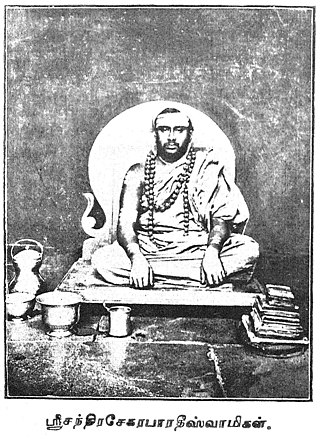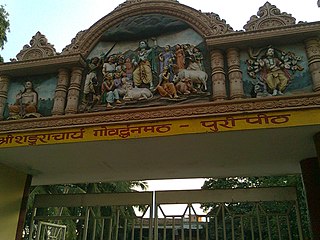
Sringeri also called Shringeri is a hill town and Taluk headquarters located in Chikkamagaluru district in the Indian state of Karnataka. It is the site of the first maṭha established by Adi Shankara, Hindu theologian and exponent of the Advaita Vedanta philosophy. Located on the banks of the river Tungā, the town draws a large number of pilgrims to its temples of Sri Sharadamba, Sri Vidyashankara, Sri Malahanikareshvara and other deities.

Shankaracharya is a religious title used by the heads of amnaya monasteries called mathas in the Advaita Vedanta tradition of Hinduism. The title derives from Adi Shankara; teachers from the successive line of teachers retrospectively dated back to him are known as Shankaracharyas.
Sri Kanchi Kamakoti Peetham, also called the Sri Kanchi Matham or the Moolamnaya Sarvagnya Peetham, is a Hindu institution, located in Kanchipuram, Tamil Nadu. It is located near the Kamakshi Amman Temple of the Shaktism tradition, along with a shrine for the Advaita Vedanta teacher Adi Shankara.

Dakṣiṇāmnāya Śrī Śāradā Pīṭham or Śri Śṛṅgagiri Maṭha is one amongst the four cardinal pīthams following the Daśanāmi Sampradaya - the peetham or matha is said to have been established by acharya Śrī Ādi Śaṅkara to preserve and propagate Sanātana Dharma and Advaita Vedānta, the doctrine of non-dualism. Located in Śringerī in Chikmagalur district in Karnataka, India, it is the Southern Āmnāya Pītham amongst the four Chaturāmnāya Pīthams, with the others being the Dvārakā Śāradā Pītham (Gujarat) in the West, Purī Govardhana Pīṭhaṃ (Odisha) in the East, Badri Jyotishpīṭhaṃ (Uttarakhand) in the North. The head of the matha is called Shankarayacharya, the title derives from Adi Shankara.

Swami Chandrasekhara Bharati was the Jagadguru Sankaracarya of Sringeri Sharada Peetham in 1912–1954. He was one of the known spiritual figures in Hinduism during the 20th century. He is a Jivanmukta.

Avani is a small village in Mulabaagilu taluk, Kolara district in Karnataka, India, about ten miles from Kolar Gold Fields. The village is located at 32 km from Kolara, the district centre and 13 km from Mulabaagilu, the Taluk headquarters. It is a popular location for rock climbing.

PascimāmnāyaŚrī Śāradā Pītham or Dwarka Sharada Math, is one amongst the four cardinal peethams established by the saint Adi Shankara to preserve and propagate Sanatana Dharma and Advaita Vedanta, the doctrine of non-dualism. Located in the city of Dwaraka, Gujarat, India it is the pascimāmnāya matha, or Western Āmnāya Pītham amongst the four Chaturāmnāya Pīthams. It is also known as the Kālikā Matha. Their Vedantic mantra or Mahavakya is Tattvamasi and as per the tradition initiated by Adi Shankara it holds authority over Sama Veda. The head of the matha is called Shankarayacharya, the title derives from Adi Shankara.

Purvamnaya Sri Govardhana Pitham or Govardhan Math is one amongst the four cardinal pithams established by the philosopher-saint Adi Shankara to preserve and propagate Hinduism and Advaita Vedanta, the doctrine of non-dualism. Located in Puri in Odisha, India, it is the Eastern Āmnāya Pītham amongst the five pithams, with the others being the Sringeri Śārada Pīṭhaṃ (Karnataka) in the South, Dvārakā Śāradā Pītham (Gujarat) in the West, Badari Jyotirmaṭha Pīṭhaṃ (Uttarakhand) in the North .It is associated with the Jagannath temple. Their Vedantic mantra or Mahavakya is Prajñānam brahma and as per the tradition initiated by Adi Shankara it holds authority over the Rigveda. The head of the matha is called Shankarayacharya, the title derives from Adi Shankara.

Sri Sharadamba Temple is a famous Hindu temple dedicated to goddess Sharadamba in the holy town of Sringeri in Karnataka, India.
Jagadguru Shankaracharya Swami Bharatikrishna Tirtha (1884–1960), born Venkataraman Shastri, was Shankaracharya of Dwaraka Math, and then of Govardhana Math in Puri in the Indian state of Odisha, from 1925 through 1960. He is particularly known for his book Vedic Mathematics , being the first Sankaracarya in history to visit the West, and for his connection with nationalist aspirations, thus earning him the title 'Father Of The Vedic Maths'.
Vidyaranyapura Agrahara is a small village near Sringeri in the state of Karnataka, India. It houses several brahmin families associated with the Sringeri Sharada Peetham and local temples.
Sacchidananda Bharati I , was a Hindu sant and religious leader of the 17th century. He was the Jagadguru of the Hindu matha Sringeri Sharada Peetham from 1623 to 1663, and is believed to have saved it from attack by spiritual means.

Samvedis or Samvedi Brahmins are an Indian Hindu Brahmin community, originating from a group of classical musicians and classical dancers. They follow Sama Veda and believed to have been originated from Odisha, India.
Nallakunta is a suburb of Hyderabad, India. Nallakunta Division Corporator:-

Sharadamba also known as Sharadambal or Sringeri Mata, is the Hindu goddess of Brahmavidya scriptures. She is also an aspect of the Hindu goddess Saraswati who is the goddess of knowledge. She is primarily worshiped in the South India such as Karnataka and Tamil Nadu.

Jagadguru Abhinava Vidyatirtha Mahaswami was the 35th Jagadguru of the Sringeri Sharada Peetham, which has been occupied by an unbroken lineage of gurus stretching back to the Advaitic philosopher Adi Shankaracharya, who established the matha for the propagation of Advaitha Vedanta.

The Advaita Guru-Paramparā is the traditional lineage (parampara) of divine, Vedic and historical teachers of Advaita Vedanta. It begins with the Daiva-paramparā, the gods; followed by the Ṛṣi-paramparā, the Vedic seers; and then the Mānava-paramparā, with the historical teachers Gaudapada and Adi Shankara, and four of Shankara's pupils. Of the five contemporary acharyas, the heads of the five Advaita mathas, four acharyas trace their lineage to those four pupils and one to Adi Shankara himself.

Uttarāmnāya Śrī Jyotish Pītham or Jyotir Math is one amongst the four cardinal pīthams established by the Ādi Śaṅkara to preserve and propagate Hinduism and Advaita Vedānta, the doctrine of non-dualism. Located in the city of Joshimath, Chamoli district, Uttarakhand, India, it is the uttarāmnāya matha or Northern Āmnāya Pītham, amongst the four Chaturamnay Peethams and in later period, Moolamnaya Sarvajna Peetham was declared as Moolamnay by disciples which is in Kalady, Kerala, birth place of Adi Shankar.
Jnanananda Bharati (1889–1975), also spelled Gnanananda Bharati, was a Sanyasi, lawyer, philosopher, writer and author. Born as Krishnaswamy Iyer to Vakil G. Ramachandra Iyer and Janaki Ammal on 26 October 1889, Krishnaswamy passed his BA, MA and BL degrees at the University of Madras and practiced as a successful lawyer at Tirunelveli.

Tummalapalli Ramalingeswara Rao was a Telugu poet, novelist, literary critic, philosophical journalist, writer of English prose and an exponent of Mantra Shastra and tradition. His works covered a wide range of subjects like history, sociology, literature, philosophy, religion and spiritualism. His popular works include Sri Lalitha Sahasranama Stotra Bhashyamu, Sri Chakra Vilasanamu, Sri Chakra Pooja Vidhanam, Dharmanirnayam, Tikkana Somayaji, Sivanugrahamu Pitruyagnamu (Poetry) and Sringeri Revisited.















